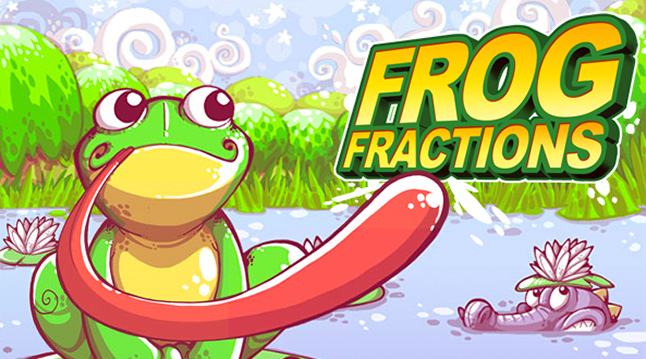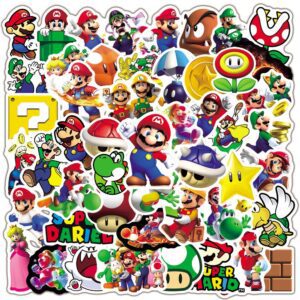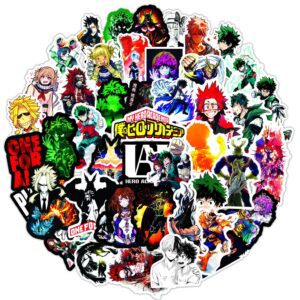Players demand sequels, but when your game depends on defying expectations, how do you pull it off again? It’s the quandary of Frog Fractions.
We live in the age of the sequel. We’ll pay $13 for a ticket to a Spider-Man “reboot” less than 10 years after Tobey Maguire first strapped on the spandex. Any video game that sells more than a dozen copies is fast-tracked for the “franchise” treatment. But Frog Fractions may be the one un-sequel-able game.
The game’s title screen promises an unremarkable edutainment vehicle, something in mold of Where In The World Is Carmen Sandiego? or Number Munchers. You control a frog on a lily pad, and your tongue shoots like a laser into oncoming swarms of insects, slurping them into your bottomless frog stomach. Each bug caught reveals a new fraction, but the fraction’s effect on the game or score is unclear. And there are other odd elements of questionable educational value—the game tracks a tally of something called “zorkmids,” there is a meter measuring the level of “indignity,” and for some reason, you can purchase a warp drive.

And thus, the player is introduced to the bizarre world of Frog Fractions, a fly-catching-tongue-in-cheek romp that is simultaneously a send-up of and loving homage to classic educational games.
I don’t blame people at all for just looking at this game and walking away. It’s supposed to look dumb. The title screen actually looks a little bit too good, I think.
“It really looks like just a janky Flash game that someone made in a couple of hours,” admits Frog Fractions creator Jim Crawford. “I don’t blame people at all for just looking at this game and walking away. It’s supposed to look dumb. The title screen actually looks a little bit too good, I think. It makes you think this game might actually have a decent art style to it. And then you get into the main game, and it doesn’t. I don’t know if that ruins the pacing of the subversion of expectations. If I were to make Frog Fractions HD, it’s one of the things I will be addressing. How do I make a crappier title screen? How can I make the game look worse?”
This “subversion of expectations” Crawford speaks of is a reference to the game’s main conceit: It’s supposedly a program that teaches fractions to kids. Anyone who grew up perusing the giants of the edutainment catalog—your Oregon Trails, your Lemonade Stands—knows the look and feel of learning that masquerades as fun. When it’s done right, it’s as though you haven’t learned anything at all. Crawford’s main regret about his game, it seems, is not doing quite enough to convince players that Frog Fractions is an earnest educational undertaking. “That was one of my decisions—that I would have to make it more interesting straightaway, or people would just walk away,” Crawford said. “And I would have loved to have been able to strike up what I feel is a better balance.”

Walking that line proved to be difficult. While it becomes clear early on that the game isn’t conventionally educational, there isn’t much to suggest that it is anything more than a nonsensical hoax, meant to waste the player’s time until they get the joke and stop playing. Alternatively, there was always the outside chance that some hapless mother would give Frog Fractions to her math-challenged child. After a few minutes of nonsensical fraction eating, the kid’s already putrid arithmetic skills would be sent into a total tailspin. Who knows what kind of long-term damage that can do? At the very least, they can say goodbye to Harvard Business School.
The game’s signal transitional moment—the point it opens up and abandons all pretense—is a moment of discovery that may not come for every player. It’s the kind of thing you might find by accident or not. “I’m not going to force people to discover this thing,” Crawford explained. “But I’m going to leave a bunch of clues. For example—and I’m just pulling this number out of my ass—if 90 percent of the people walk away without realizing what is going on, I’m going to be pleased because I was able to give the 10 percent that ‘holy shit’ experience.”

This moment contains something of the DNA of the film director M. Night Shyamalan, whose movie The Sixth Sense hinged on a big reveal toward the end that changed the lens through which everything leading up to that point is viewed. It was a gimmick, but Shyamalan pulled it off with a such skill that every film he made thereafter was expected to have a similar twist. Crawford’s Sixth Sense moment isn’t quite the same thing—it happens toward the beginning of the game, for one—but the prognosis for future endeavors is similar. The impossibility of recreating that “a-ha!” moment, since everyone will now be on the lookout for it, destroys the illusion and puts him in danger of being pigeonholed as a game maker.
But Crawford isn’t interested in following Shyamalan into a sticky morass like The Village or Lady In The Water, where fans who wanted a recreation of the initial jarring experience balked at the quickly diminishing returns brought about by heightened expectations. “After a while, it’s no longer subverting much, because you just expect the craziest shit out of it, and then I have to play into that, you know?” Crawford said. “People have asked for a Frog Fractions 2, and I don’t know how I could do that. As the ‘Frog Fractions Guy,’ there are so many expectations I could subvert just by doing nothing—just by being a dick and putting out a game that really is just an educational game. So for a Frog Fractions 2, I could spend the next year and make a sequence of really funny stuff, and people would be entertained by it for 45 minutes, like before. But I don’t know how I can make the discovery experience again. I don’t know how I would do that. And I think that is so core to what Frog Fractions is. Until I figure out how to do that, making Frog Fractions 2 would just be dumb.”
I’m not sure I agree (at least totally) with Crawford’s assessment that the early twist is such an essential pivot of the game. It sells Frog Fractions a wee bit short, in that it downplays the hilariously creative wackiness that infuses everything that comes after the “twist.” Precisely because he didn’t make a concerted and prolonged effort to maintain the educational pretense, the fact that it stands up fine on its own even after the joke is over suggests it’s more than a one-trick pony. It’s hard to say whether that could carry over into a worthy sequel, but I have to respect Crawford’s reluctance to do it unless he can get it right.













